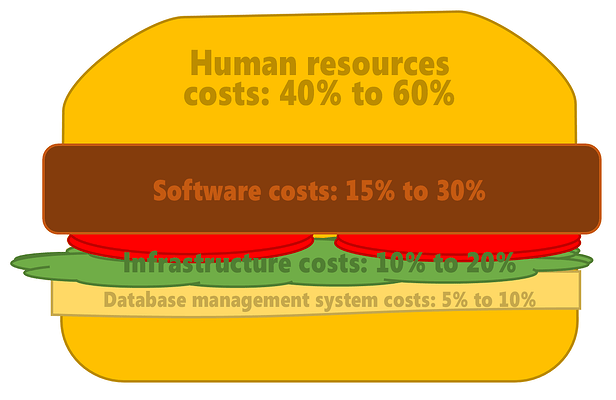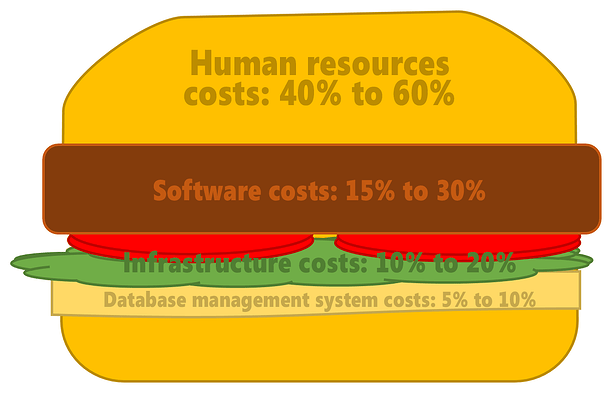Implementing an Enterprise Resource Planning (ERP) system is what many manufacturing companies undertake to help manage the workload. The process may not be easy, but when considering the time and effort it takes to collect, interrupt, and keep track of data on a spreadsheet (especially if you are a medium to large size enterprise), it is well worth the time and money.
Price is Dependent on Needs
The cost of the ERP software varies greatly depending on the company’s needs, such as:
- The type of system your finance and operations needs to grow
- The size of your organization
- The desired amount of functionality
- The number of users/locations
These are going to be the biggest factors that will determine the price of the software license. Generally speaking, the more you need in any of these areas, the more the user license will cost.
Implementation Has Four Costs
The cost of the actual ERP software is not the only expense you have to consider. The most anticipated part of a burger might be the patty, but it still needs the cheese, veggies, and bun to be a burger. Similarly, the cost of implementation is made of different parts that make the overall grand total:
- Human resources costs: 40% to 60%
- Software costs: 15% to 30%
- Infrastructure costs: 10% to 20%
- Database management system costs: 5% to 10%
Cost of implementation breakdown
The infographic above gives you a general idea of the impact each expense has on the overall cost of implementation. As I have demonstrated, the exact percentages vary depending on your company’s specific needs.
What Are You Paying For?
Human Resources Costs
Human resources are the bread that holds the operation together. It includes the implementer's fee, consultant's fee, and your employees’ salaries during training. Human Resources usually amounts to around 50% or more of the total implementation costs.
Software Costs
The software is the meat of the operation, and without it there is nothing to implement. In addition to the factors mentioned earlier for software costs, the company's industry and customization needs also affect the total cost.
The industry affects the cost, because some industries require more functionality than others, and if the software isn’t made for your industry it may require a lot of customizations and extensions to meet your company’s needs.
Customizing the ERP software is necessary for many companies whether the software is made for your industry or not. Determining the cost of customization is a bit trickier than determining the licensing cost because it requires a detailed look into your company’s functional needs. Some of the things to consider are:
• The data fields you need to track and report
• Dashboard, management, and operational reports
• The complexity of workflow
• User interface changes
Of course, not all of these factors apply to every ERP system. For example, Acumatica has a one-time user/subscription fee, meaning that there is only one user fee for everyone in your company to get access. So, you’re only paying for the software and annual maintenance for a traditional license or, for a SaaS subscription, you pay an annual fee for the software, environment, and maintenance.
Infrastructure Costs
The infrastructure facilitates the software and keeps it operating. Similar to what veggies do for the body, without infrastructure the software has nothing to run on. Infrastructure costs basically include the cost of the hardware, backups, storage, desktop computers, and server infrastructure.
Database Management System Costs
Let's face it, cheese makes the burger better. Database management systems do the same thing for the software. They are used to manage the storage, retrieval, and automated updating of the data in an ERP system. The licenses for database management systems are usually bought separately from the ERP system, but they can be included in the implementation cost. Microsoft SQL Server or Oracle are most commonly used.
Other Costs
Although these were not demonstrated in the graphic, these are the ketchup and mustard that's added to the burger for taste. Ketchup is data migration and mustard is the license renewal fee.
Data migration cost is determined by the amount of data being moved, the complexity of that data, the availability of migration tools, and the gaps of information between your current software and the new software. Because of these factors, the cost of migrating from spreadsheets is generally greater than migrating from another business software solution.
The typical license renewal fee is between 10% to 15% of the initial software cost. Recurrent costs vary because some vendors will charge a low implementation fee, then charge a high rate to renew the license.
Factoring all of the costs that go into the overall price of implementation, a standard ERP implementation for a medium-sized organization can cost anywhere from $150,000 to $750,000.
Of course, these are all broad figures to give you a general idea of your costs, and why it’s a necessary part of the process. The reality is that no two companies' implementations are going to be the same, because no two companies are the same. Despite varying needs, the majority of manufacturers seem to agree that ERP is the best option for modern business management.
If this article has peaked your interest in implementing an ERP solution, leave it to Clients First’s capable staff of professionals to help your company get started. Contact us at 800.331.8382 or sales@clientsfirst-tx.com. Our sales team is waiting to hear from you.
 What is the Cost of Implementing ERP?">
What is the Cost of Implementing ERP?">
